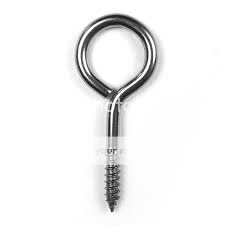friendcaique
New member
Is cotton rope safe for your bird because i think I have heard some terrible stories of cotton rope killing or injuring birds

Follow along with the video below to see how to install our site as a web app on your home screen.
Note: This feature may not be available in some browsers.
Is cotton rope safe for your bird because i think I have heard some terrible stories of cotton rope killing or injuring birds


I feel the need to update this thread.
Please, be VERY careful with eye screws (stainless or not). Many toys, unfortunately come with those. If you have an avid chewer, those eye screws come off and can pose a terrible danger to our fids.
This is what they look like:
The toy below is dangerous. Not only does it have one of those eye screws, but a bird's head can get stuck in between. (It's happened to my Sam...and I know of another member whose bird got stuck in it)

Never leave your rope strands longer than 3 inches and only use Supreme or Superior cotton for birds. It is a special rope that pulls apart. Never use polyester for your birds. Whether it is fleece or rope or yarn. As for the eye screws, that is part of our daily inspection of toys. Check them to see if they are loose or if the screw area can be seen. If so remove them immediately. I do agree though, always watch your bird with a new toy.
Never leave your rope strands longer than 3 inches and only use Supreme or Superior cotton for birds. It is a special rope that pulls apart. Never use polyester for your birds. Whether it is fleece or rope or yarn. As for the eye screws, that is part of our daily inspection of toys. Check them to see if they are loose or if the screw area can be seen. If so remove them immediately. I do agree though, always watch your bird with a new toy.
I disagree about the polyester/fleece..I know many, many people who use that for huts and swings with zero issues. It has to NOT be flame retardant, however.
I find 100% cotton used in huts and swings pills, and can cause issues if the bird eats it.
I am more concerned about the chemicals in the polyester. Unfortunately, the damage that is being done is going to show up maybe 5 - 6 years from now, not right away. I respect everyone's personal decision. I just ask you to go and research polyester to see what it is made of, what is used to dye it and the government regulations on fire retardants. Please.
You are absolutely right about cotton and chemicals. Cotton fields are constantly sprayed with various fertilizers and such, except organic which is obviously best, but quite expensive. Some can be washed away but others are actually embedded into fibers. Polyester is made from chemicals and nothing else. One of the main polymers is ethylene glycol, a.k.a antifreeze. I don't feel comfortable using this for my birds. My sources are from various manufacturers of synthetic and organic fleece, as well as test conducted at the biotech lab at Georgian University. Obviously everyone needs to made there own decisions, I am only trying to pass on information that may be potentially hazardous to our little friends.Thank you for the recommendation to research, I always do that before using anything around my flock
Cotton can have many chemicals as well, unless you are buying organic cotton.
Happy huts, these are deadly and so many parrots have been injured or killed because of them

This style of plastic toy can strangle parrots(the middle plastic part slides around making it dangerous). One member a while ago mentioned it happening to their bird while they played with a similar toy - luckily they were home and could save them.

Happy huts, these are deadly and so many parrots have been injured or killed because of them

This style of plastic toy can strangle parrots(the middle plastic part slides around making it dangerous). One member a while ago mentioned it happening to their bird while they played with a similar toy - luckily they were home and could save them.

Wanted to "bump" the hazard of Happy Huts due to recent tragedies.
Speaking as a chemist...One thing to bear in mind when discussing chemicals....many beneficial things are made from poisons. For example, gentle glycerin soap is made with lye, a poisonous and corrosive chemical that causes burns. While toxic chemicals may go into plastic production, they are usually completely converted or removed from the final product. I personally would not worry about a bird getting poisoned by any residual chemicals in polyester fleece. I would worry about the toxic fumes that would be released if it were to catch fire, or about fire retardant chemicals added to it. I'd worry about those same compounds being added to cotton or linen, though. Artificial colors are are worse problem - some of these, especially the red colors, are bad. For any chemicals to harm the bird, they have to get into the system. Since many plastics are not water soluble, this actually makes them safer for birds because they are less likely to be injested. Dyes are usually water or alcohol soluble, and can migrate into food, water, wet feathers - and if injested will be easily absorbed into the body. Anything that touches the bird, I wash in water and then in alcohol. Or vodka. Water soluble chemicals will dissolve in water, and many oil-soluble compounds will dissolve in alcohol.
Another risk is internal blockage from eating the stuff. If a bird chews rope, or cloth, or paper there is always a risk that some of it is being swallowed. If it's small enough bits, and just a few, maybe it can be safely eliminated. Natural fibers might even be worse - they might be more easily fractured into tiny bits that can be swallowed, while synthetics might have enough strength to stay in long strands that don't get eaten. On the other hand, natural fibers might be less likely to create long strands that could strangle a bird.
People seem to know about using stainless steel over galvanized metal, but some cheap stainless - especially from overseas - can be contaminated with cobalt, chromium, etc. I know you don't have much choice when it's already in the toy, but if you are making your own toys you can be more particular about sourcing the materials. Leather is another unexpected problem - most commercial leather is chrome tanned, and full of toxic chemicals. Even some vegetable tanned leather has been produced by starting with chrome tanned leathers. Pure vegetable tanned, undyed leathers are available. I trust the ones from Siegel Leather - be explicit about what you are looking for, and Steve Siegel will make sure you get the proper leather.
My current belief system holds these as facts:
1. Wash all materials and toys in water, alcohol, and let dry before using.
2. Watch carefully for signs of fraying and replace items at once.
3. Take the bird's habits into consideration when selecting materials (are they a chewer or a bonker)
4. Use only stainless steel or vegetable tanned, undyed leathers to hang chew toys.
